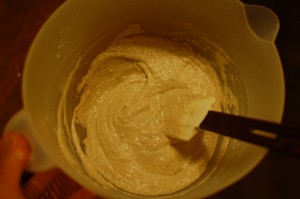 When feeding a sourdough starter culture, it is normal practise to throw away the portion of culture that is removed and replaced with fresh flour.
When feeding a sourdough starter culture, it is normal practise to throw away the portion of culture that is removed and replaced with fresh flour.
We have a thing about waste. The prospect of throwing away something that could be turned into food grates, and so we set about trying to find a way to utilise this redundant mixture.
The interweb proposed the suggestion of pancakes. We approved, experimented with and tweaked what we found, and present our own version here. This makes approximately 12-14 small scone sized pancakes.
Every time we feed our sourdough culture, we add the removed portion of culture to a pot that is kept in the fridge. The resulting mixture develops quite a tart flavour, doesn’t have quite the ‘fizz’ that the regularly fed fresh culture has, but still has enough vigour to do its job. When we have sufficient quantity, we make pancakes ( at least once a week ).
Overnight sponge :
120g flour ( white makes lighter pancakes, but rye works well, just add a little more liquid )
14g honey or sugar
56g milk, 170g natural yoghurt ( or whatever ratio you have to hand to make 226g, or you could use 226g of buttermilk )
120g unfed sourdough starter culture.
The honey and yoghurt lend more life to the mixture. Mix and leave in a warmish spot ovenight.
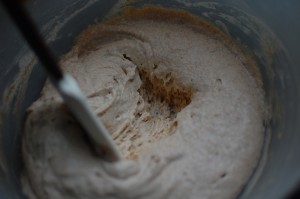 The following morning, the mix should should show signs of being alive. It will have increased in volume, have a spongey texture, be full of air. This morning we used rye flour which, because it doesn’t develop gluten, doesn’t rise sufficiently to trap the air. Some mornings during the summer, when using white flour, the resulting sponge is nearly overflowing the bowl.
The following morning, the mix should should show signs of being alive. It will have increased in volume, have a spongey texture, be full of air. This morning we used rye flour which, because it doesn’t develop gluten, doesn’t rise sufficiently to trap the air. Some mornings during the summer, when using white flour, the resulting sponge is nearly overflowing the bowl.
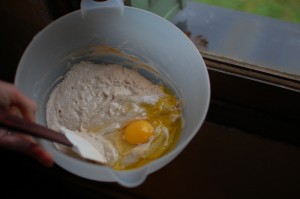 Mix in one large egg, 25g oil or butter and half a teaspoon of salt. The mixture is quite thick, not at all runny.
Mix in one large egg, 25g oil or butter and half a teaspoon of salt. The mixture is quite thick, not at all runny.
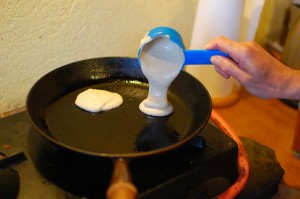 Heat a little oil in a heavy frying pan, pour in several small amounts of mix with enough space between each to spread a little.
Heat a little oil in a heavy frying pan, pour in several small amounts of mix with enough space between each to spread a little.
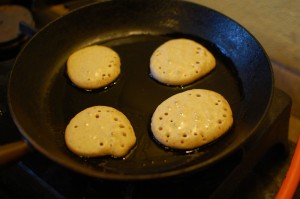 As you can see, these pancakes are more like drop scones, not thin so that they cover the entire base.
As you can see, these pancakes are more like drop scones, not thin so that they cover the entire base.
When small air pockets start to form on the topside, and the undersides are nicely browned …
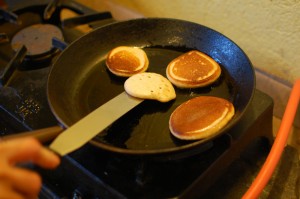 … flip them over to brown the reverse side.
… flip them over to brown the reverse side.
Cook in small batches, keeping the cooked ones warm in a low oven until ready to serve.
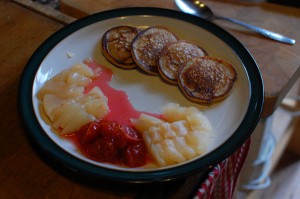 Serve with whatever takes your fancy.
Serve with whatever takes your fancy.
This morning, we had poached apples and pears, plus some conserved wild plums with a little drizzled honey.
